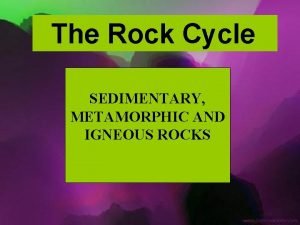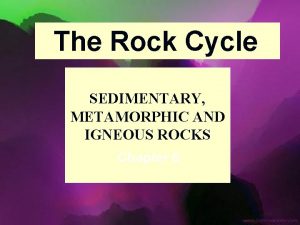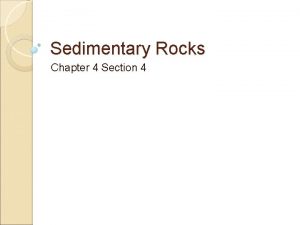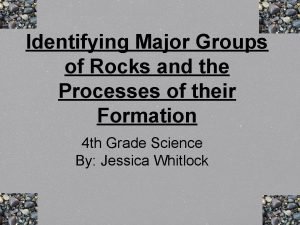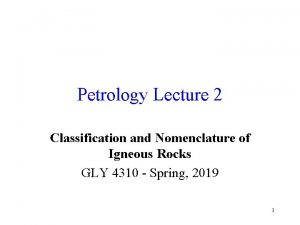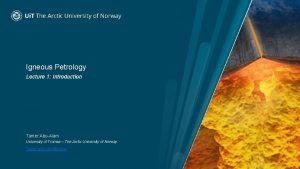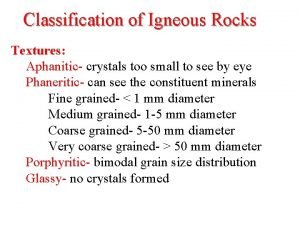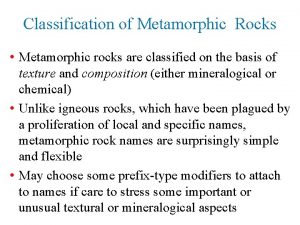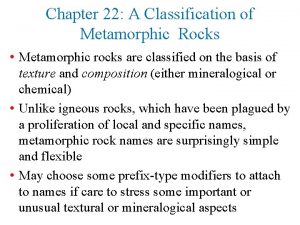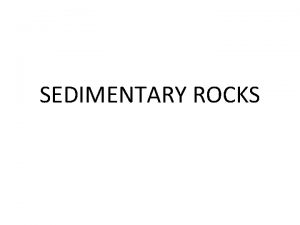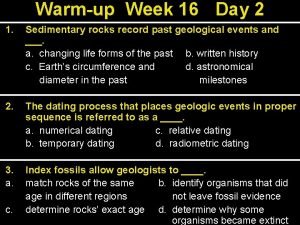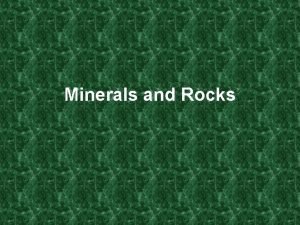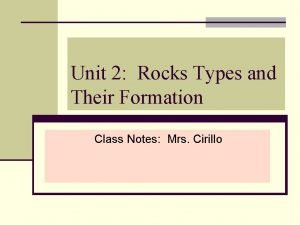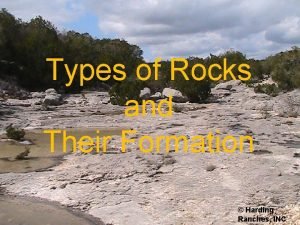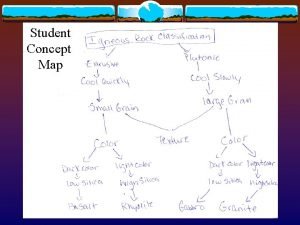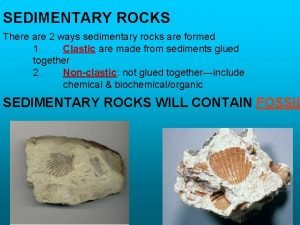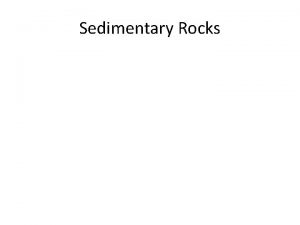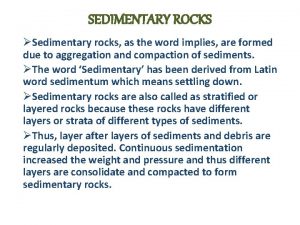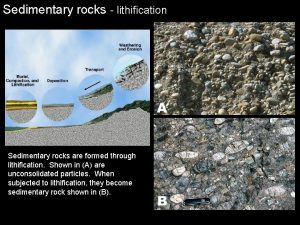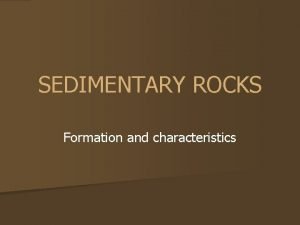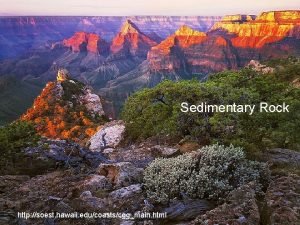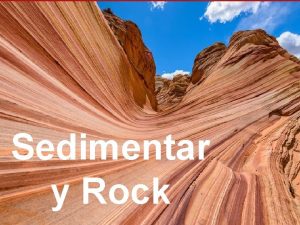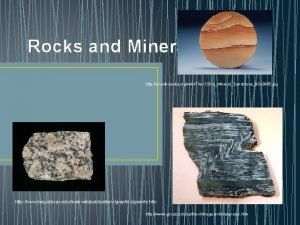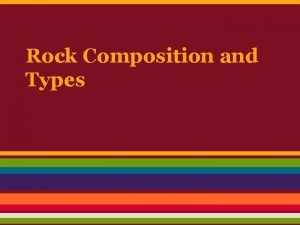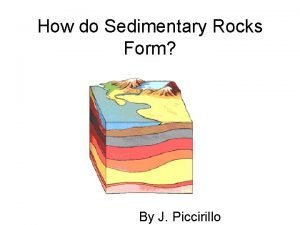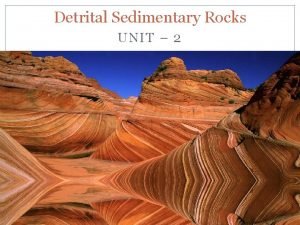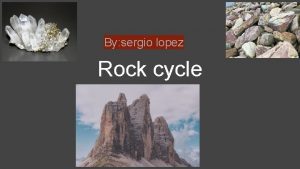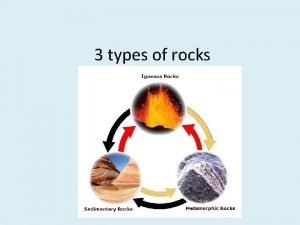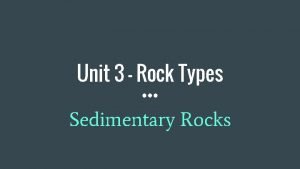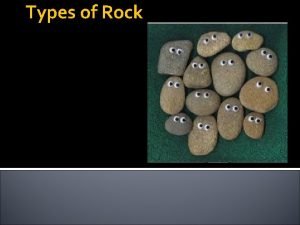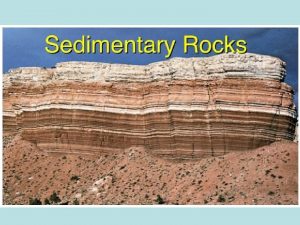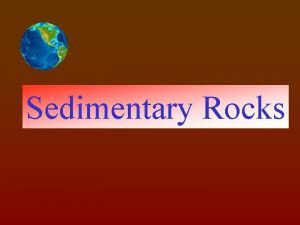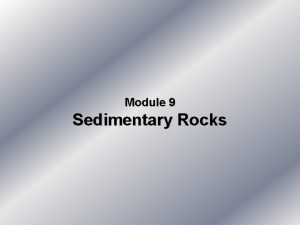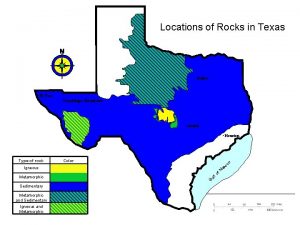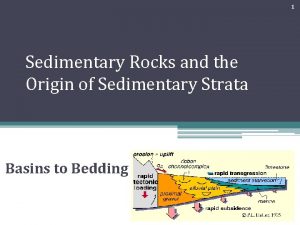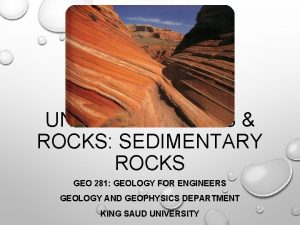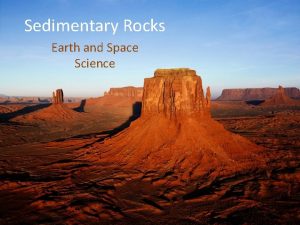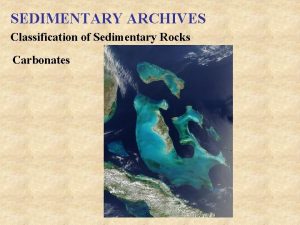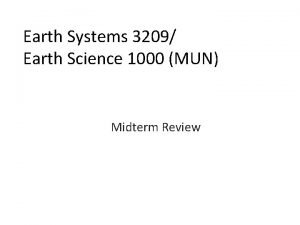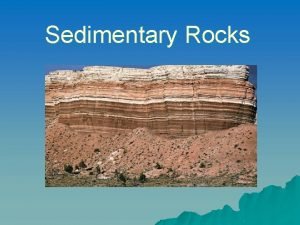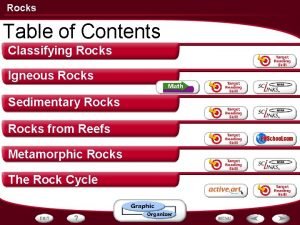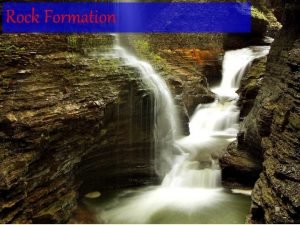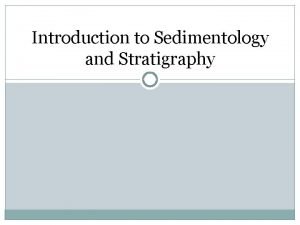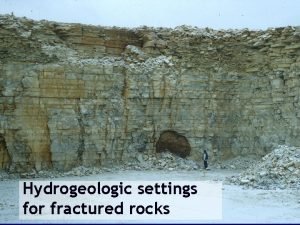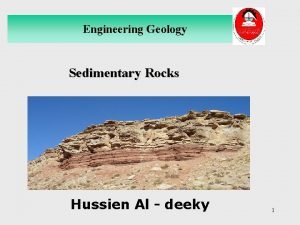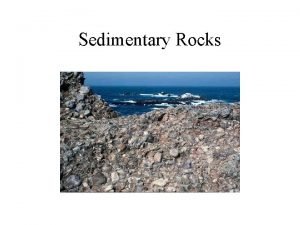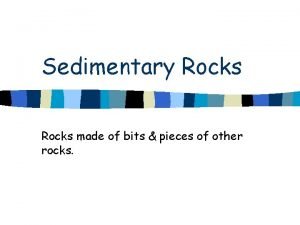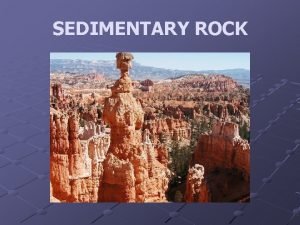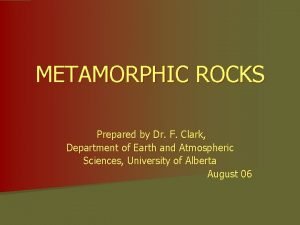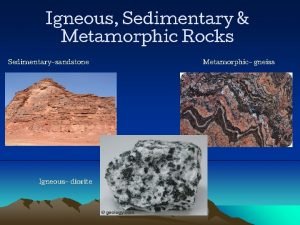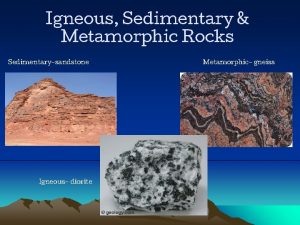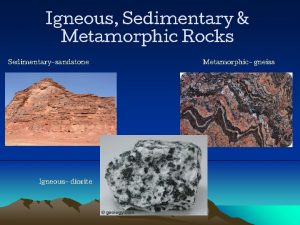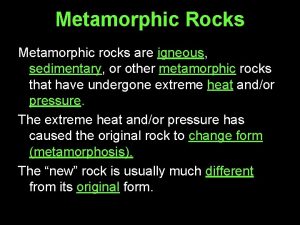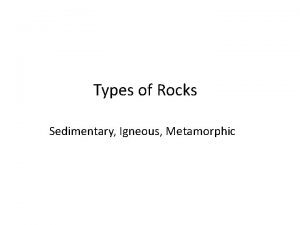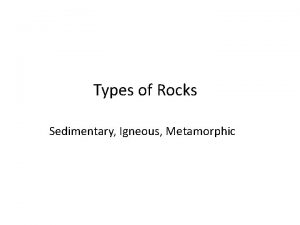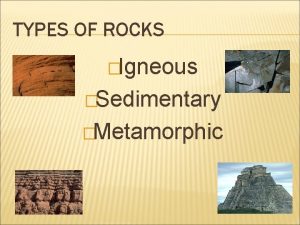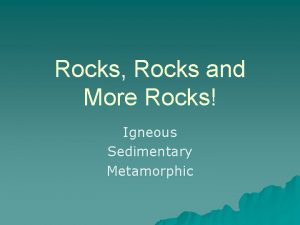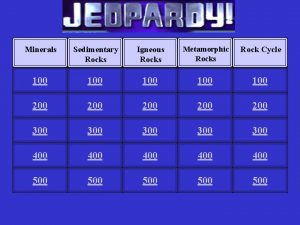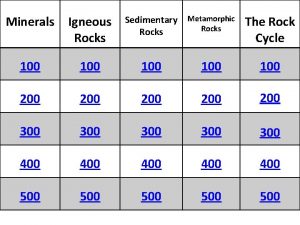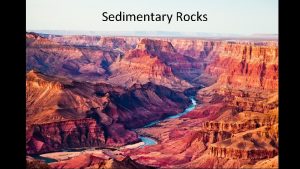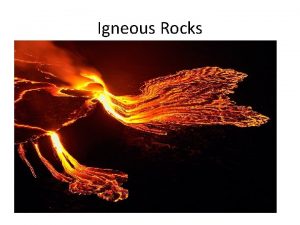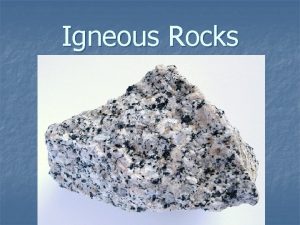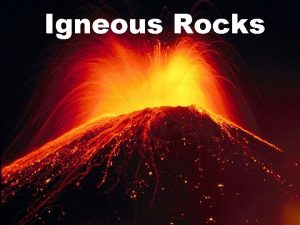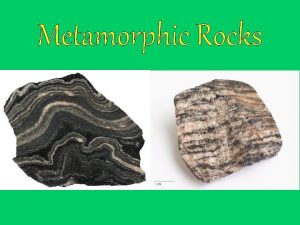Rocks Classification of Igneous Sedimentary and Metamorphic Rocks















































































- Slides: 79

Rocks Classification of Igneous, Sedimentary and Metamorphic Rocks

ROCK CYCLE • Equilibrium • Interrelationships between – – – igneous rocks sedimentary rocks metamorphic rocks weathering and erosion


IGNEOUS ROCKS EXTRUSIVE Volcanic- Fine-grained INTRUSIVE Plutonic- Coarse-grained

MAGMA • Molten Rock – Usually with dissolved gasses • Generated at depth • Eruptions if magma (lava) reaches surface • If doesn’t reach surface, Solidifies underground – – – Intrudes country or host rock Intrusive contact Xenolith- ‘foreign body’


Igneous Rocks • Names based on mineral composition reflects chemical composition of the magma and. . . Grain size – Very coarse-grained Pegmatitic – Coarse-grained: Phaneritic > 1 mm. – Fine-grained: Aphanitic < 1 mm. – Porphyritic- 2 crystal sizes





Igneous Rocks. Classification • Coarse-grained • Plutonic (Intrusive) – – Granite (Sialic) (SIlica and ALuminum rich) Diorite Gabbro (Mafic) (MAgnesium and iron (FE) rich) Dunite & Peridotite (Ultramafic) • Fine-Grained • Volcanic (Extrusive) – Rhyolite (Sialic) – Andesite – Basalt (Mafic)


Igneous Rock Identification • Granite (& Rhyolite) – – High in Si + O Low in Fe + Mg Mostly feldspar & Light-colored quartz • Basalt (& Gabbro) – – “Low” in Si + O High in Fe + Mg no quartz, abundant ferromagnesian minerals Dark colored • Andesite (& Diorite- intermediate)







WEATHERING, EROSION, TRANSPORTATION • Weathering- Physical disintegration and chemical decomposition of rocks • Erosion- Physical removal • Transportation- Movement of eroded particles • Chemical vs. Physical Weathering • Effects of weathering – – – Surface alteration of outcrops Spheroidal weathering Differential weathering

Physical Weathering




Differential Weathering



Frost Action


Exfoliation


Organic Action

ROCK CYCLE

Relative Percentages of Sedimentary Rocks

SEDIMENT • Particle size – Pebbles, cobbles, boulders – Gravel- > 2 mm – Sand- 2 mm - 0. 063 mm – Silt - 0. 063 mm - 0. 004 mm – Clay- < 0. 004 • Deposition Clay-sized particle vs. clay mineral



TYPES OF SEDIMENTARY ROCKS • Clastic or Detrital • Chemical- inorganic precipitation or evaporation • Biochemical- Organic remains – shells, charcoal, plant fragments

CLASTIC (Detrital) ROCKS • Breccia and Conglomerate (> 2 mm) – Sedimentary Breccia- angular fragments – Conglomerate- rounded fragments • Sandstone (2 mm - 0. 063 mm) – Quartz sandstone – Arkose (feldspar) – Graywacke (appreciable amounts of silt/clay) • Fine-grained Matrix • Usually from turbidity currents



Quartz Sandstone

• CHEMICAL SEDIMENTARY ROCKS Carbonate Rocks – Limestone- made of calcite • Inorganic varieties – micrite, oolites, travertine – Dolomite – Recrystallization • Chert- silica • Evaporites – Rock gypsum – Rock salt


BIOCHEMICAL SEDIMENTARY ROCKS • Coal – Develops from peat • plant fragments – Lignite – Bituminous Coal • Carbonate Rocks – Limestone- made of calcite • organic varieties – Coquina – Fossiliferous Limestone – Chalk




SEDIMENTARY STRUCTURES – Cross-bedding – Graded bed – Mud cracks – Ripple marks – Fossils


Mudcracks



Sedimentary Rocks as Resources • Non-Metallic – Sand gravel – Limestone – Clay – Gypsum • Energy Resources – Oil and Gas – Coal

Formation of Oil and Gas





U. S. Coal Production

Metamorphic Rocks • Metamorphism – Increase in Pressure; increase in Temperature • Burial • Contact • Regional • Metamorphic rock – Pre-existing rock – Parent rock




Foliation






Classification A- Slate C- Phyllite D- Schist E- Gneiss F- Migmatite

Classification






 Igneous and metamorphic
Igneous and metamorphic Igneous metamorphic sedimentary
Igneous metamorphic sedimentary Concept map igneous rock
Concept map igneous rock Formation of metamorphic rocks diagram
Formation of metamorphic rocks diagram It was a sedimentary rock song
It was a sedimentary rock song Rock cycle chart
Rock cycle chart Etamorph
Etamorph Rock cycle song (sedimentary igneous metamorphic)
Rock cycle song (sedimentary igneous metamorphic) Sedimentary and metamorphic rocks section 6.1
Sedimentary and metamorphic rocks section 6.1 Sedimentary igneous rocks
Sedimentary igneous rocks Sedimentary igneous rocks
Sedimentary igneous rocks Cementation sedimentary rocks
Cementation sedimentary rocks Sedimentary rocks turn into metamorphic
Sedimentary rocks turn into metamorphic Ultramafic rock classification
Ultramafic rock classification Aphanetic
Aphanetic Iugs classification of igneous rocks
Iugs classification of igneous rocks Iugs classification of igneous rocks
Iugs classification of igneous rocks Classification of metamorphic rocks
Classification of metamorphic rocks Ortho metamorphic rocks
Ortho metamorphic rocks Metamorphic sedimentary
Metamorphic sedimentary Metamorphic sedimentary
Metamorphic sedimentary Detrital
Detrital Sedimentary rocks record past geological events and ____.
Sedimentary rocks record past geological events and ____. Types of rocks metamorphic
Types of rocks metamorphic Igneous rocks extrusive and intrusive
Igneous rocks extrusive and intrusive Intrusive vs extrusive igneous rocks
Intrusive vs extrusive igneous rocks Meta - change morph
Meta - change morph Sedimentary weathering
Sedimentary weathering Esrt sedimentary rocks
Esrt sedimentary rocks Sedimentary rocks examples
Sedimentary rocks examples Concept map of sedimentary rocks
Concept map of sedimentary rocks Sedimentary rocks
Sedimentary rocks How do we name clastic sedimentary rocks?
How do we name clastic sedimentary rocks? Sedimentary
Sedimentary Characteristics of sedimentary rocks
Characteristics of sedimentary rocks Ripple marks
Ripple marks In sedimentary rocks lithification includes
In sedimentary rocks lithification includes Sedimentary rocks characteristics
Sedimentary rocks characteristics Sorting sedimentary rocks
Sorting sedimentary rocks Clastic sedimentary rocks
Clastic sedimentary rocks Where does coal form
Where does coal form Facts on sedimentary rocks
Facts on sedimentary rocks Metamorphic rocks properties
Metamorphic rocks properties How could you tell
How could you tell Classify sedimentary rocks
Classify sedimentary rocks Sedimentary rocks leaving cert
Sedimentary rocks leaving cert Esrt sedimentary rocks
Esrt sedimentary rocks Features of sedimentary rocks
Features of sedimentary rocks Clasts detrital minerals
Clasts detrital minerals Characteristics of sedimentary rocks
Characteristics of sedimentary rocks Facts on sedimentary rocks
Facts on sedimentary rocks Metamorphic rocks form from
Metamorphic rocks form from Compaction and cementation
Compaction and cementation Uses kf
Uses kf How do the rocks stick together to undergo lithification?
How do the rocks stick together to undergo lithification? Transportation of sedimentary rocks
Transportation of sedimentary rocks Q
Q Types of rocks in texas
Types of rocks in texas Orthochemical and allochemical
Orthochemical and allochemical Detrital
Detrital Sedimentary rocks
Sedimentary rocks How are sedimentary rocks formed
How are sedimentary rocks formed Silicon oxygen tetrahedron
Silicon oxygen tetrahedron How are sedimentary rocks formed
How are sedimentary rocks formed How are sedimentary rocks made
How are sedimentary rocks made Classifying rocks
Classifying rocks Properties of a sedimentary rock
Properties of a sedimentary rock What are sediments?
What are sediments? Sedimentary rocks
Sedimentary rocks Importance of metamorphic rocks to man
Importance of metamorphic rocks to man Sedimentary rock
Sedimentary rock Rochas
Rochas How is chemical sedimentary rock formed
How is chemical sedimentary rock formed Characteristics of sedimentary rocks
Characteristics of sedimentary rocks Process of formation of sedimentary rocks
Process of formation of sedimentary rocks Sedimentary rocks
Sedimentary rocks Fossils in sedimentary rocks
Fossils in sedimentary rocks Schist rock
Schist rock Angular sedimentary rocks
Angular sedimentary rocks Sedimentary rocks
Sedimentary rocks




